
Features
Growing Media
Inputs
Special Series: in the rootzone #15
November 25, 2013 By Hans van Herk
In his third of four articles for Greenhouse Canada, Grodan crop consultant and young plant specialist Hans van Herk provides an insight into the world of high-tech tomato propagation and describes how young plant development can be steered in propagation so that quality plants are delivered to the greenhouse.
Grafting is now universally accepted as the norm for tomato plant production as these plants ultimately produce higher yields and better quality fruits. Increasingly, propagators are exerting greater control over young plant development to produce different plant types at the request of their customers, the growers. There are three different specifications to choose from:
- Single-headed plants.
- Pinched plants on the second true leaf.
- Pinched plants on the cotyledons.
Which is the best? That depends on your situation and the tools at your disposal. Needless to say, each plant type has its own unique features and it is very important for the propagator to know what you require.
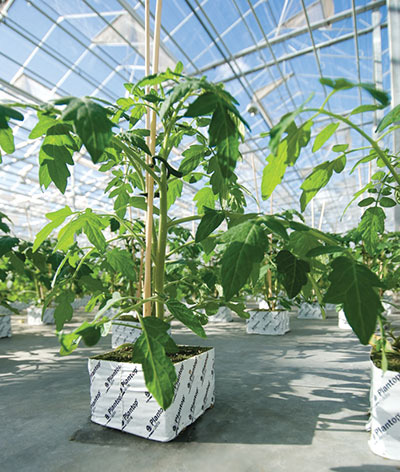 |
|
| Picture 1: A single-headed grafted tomato plant. Note that the plants are in a 10 x 15 cm Plantop Delta block, which will allow the grower to extend the period of time the plants can be controlled beside the plant hole once they are delivered to the greenhouse.
|
Single-headed plants (Picture 1) are naturally strongly vegetative and will yield a high total production. It is important these plants are spaced quickly once they are rooted into the block (to an interim density of approximately 40 plants per square metre) in order to prevent them stretching too far.
The first two clusters typically have excellent quality appearing after seven to nine and 10 to 12 leaves, respectively. These plants are usually delivered at ±50 days (Table 1).
As they are strong vegetative plants, they therefore require a strong generative stimulus in the greenhouse. It is therefore preferable to work directly with a large day-to-night temperature difference of 6 to 7 C and to stand these plants beside the plant hole for seven to 10 days prior to planting. However, if 10 x 15 cm blocks are used, it may be possible to extend the control phase until the second truss is flowering in order to exert greater generative control.
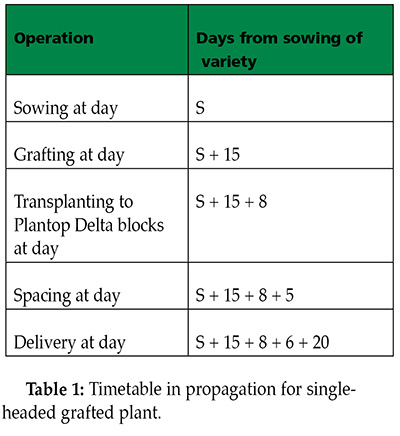 |
|
Plants pinched on the second true leaf (Picture 2) are naturally generative, but with growth power coming from the powerful rootstock, in most cases Maxifort, the plant develops quickly.
 |
|
| Picture 2: A tomato plant grafted and pinched on the second true leaf.
|
After pinching, they need to be spaced quickly (after three days) to an interim density of 70 heads per square metre to ensure the uniform development of both shoots. The first cluster usually appears after six leaves on the new shoots and the second cluster after nine to 10 leaves, consequently this plant type will produce an early first harvest.
These plants are normally delivered at ±55 days (Table 2). However, as grafting and pinching are undertaken over a short period of time, the quality of the initial clusters can be somewhat lower. These plants therefore require less generative steering and if required can be planted directly to the slab and steered with a flatter day-to-night temperature regime.
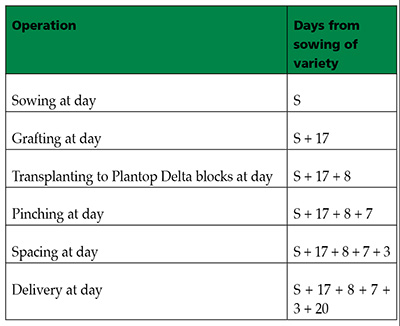 |
Table 2: Timetable in propagation for a grafted plant that is pinched on the second true leaf.
Plants pinched on the cotyledons (Picture 3) are more vegetative than those pinched on the second true leaf but possess less growth power than single-headed plants. When radiation levels are high, the first cluster will appear after seven to eight leaves, and the second after 10 to 11 leaves. Their quality is normally very good, although care should be exercised when propagating in low light conditions as development of two uniform shoots can be difficult. These plants are usually delivered at ±60 days (Table 3).
JAPANESE TOP GRAFT
The standard way to graft tomato plants is to use the “Japanese top graft.” This method involves cutting the rootstock and variety at an angle of 45 degrees that maximizes the contact area to secure a good graft union.
 |
|
| Picture 3: A tomato plant grafted and pinched on the cotyledons.
|
The rootstock is always cut below the cotyledons. This saves a lot of labour in propagation as the shoots that would otherwise grow from the cotyledons of the rootstock will not need removing.
For the variety that will be pinched on the second true leaf, the cut is made above the cotyledons; hence, the seedling is older when the graft is made (Table 2). A silicon clip is then used to hold the union in place while the wound heals.
For single-headed grafted plants and those pinched on the cotyledons, the cut is made below the cotyledons. To ensure a good graft union, it is important that the stems of the rootstock and the variety are of the same diameter. This is achieved by selecting the rootstocks and grading them accordingly.
For the plant, grafting is a brutal operation, so the seedlings need to be placed in a controlled environment. This can be either a high-tech growth room or simple plastic tent. The temperature should be held at a constant 22-23 C with a humidity >98 per cent until the wound is healed. If these two elements are not realized, there will be a high failure rate with huge cost implications.
After four or five days, the wound is usually healed and guttation on the young seedlings may be seen. This is the first sign that the rootstock is once again able to pump water to the leaves and it is time to start the acclimatization process so the tents must be opened to allow the humidity to be lowered.
The water will evaporate quickly and after two or three hours at a temperature of 22 C the plants may start wilting. This is perfectly normal: the plants should be covered again to allow them to recover. This process is repeated over a period of several days, leaving the plants exposed for increasing lengths of time until they are strong enough to leave the tent altogether.
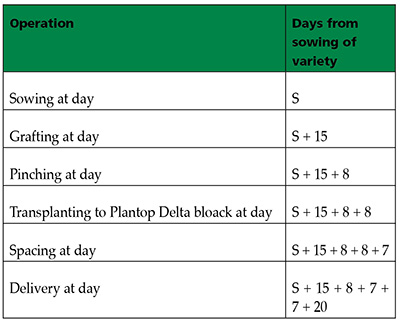 |
Table 3: Timetable in propagation for a grafted plant that is pinched on the cotyledons.
PINCHING
Pinching is another brutal operation for the young seedling because, for the second time, the plant is effectively decapitated. This action removes the dominance of the apical bud with the objective of producing two identical shoots.
Pinching on the second true leaf is the most common plant type requested by growers today. With this plant type transplanting to the Plantop Delta blocks occurs prior to pinching (Table 2). To reduce stress conditions as much as possible, the young plant must have rooted into the block before the pinch is made. This, along with timely spacing, will assist in the development of two uniform shoots.
PINCHED AT THE COTYLEDONS
This plant type is usually pinched eight days after grafting (Table 3) when the seedlings are still in the sowing plug. After pinching they can stay for a further eight days in the sowing plug prior to transplanting (Table 3).
The spacing within the plug tray will be dependent on the outside weather conditions. For example, when radiation and temperatures are high, a higher density will provide a better vegetative microclimate for the seedlings.
Conversely, when the radiation and outside temperatures are low, a lower density (50 per cent) in the plug tray will be better. These actions are used to influence uniform stem development and the formation of the initial cluster.
If the conditions in the first three to four days after pinching are too generative, the cluster appears too low after four leaves on the shoot. If the conditions are too vegetative, the cluster appears too high, after 10 to 12 leaves on the shoot.
STEERING GROWTH IN WARM CONDITIONS
Once the grafted plants are rooted into the blocks, their subsequent development can be steered in a generative or vegetative direction.
Increasingly the trend in Europe is to go for older, more compact, generative plants, particularly in the case of crops planted between July and November for continued growth under assimilation lights over winter.
During propagation the light levels are relatively high and night temperatures are warm. An older plant specification in these situations delivered with second or third cluster in flower gives the plants a certain level of development, making it easier for the grower to balance the crop once the plants are delivered to the greenhouse.
More importantly, there are direct financial benefits to be gained, as this strategy increases productivity by extending the harvesting period of the old crop (it can stay in production longer) and producing an earlier first harvest from the new crop.
COMPARISON TO CANADA
Warm conditions during propagation, especially warm nights, mean that it is not easy to control or steer plant growth based on temperature. The only way to steer plant development is to manipulate the water content and EC of the blocks, play with plant nutrition, and particularly nitrate nitrogen levels, and plant density.
Although in Canada it would be virtually impossible to deliver a flowering plant of the specification shown in the photo on this page (you have huge transport distances and cannot use bees), we can draw comparisons to how the plants are steered in warm conditions.
Controlling plant growth begins when the blocks are spaced on the ebb and flood floors. At this stage in the propagation cycle, the EC of the irrigation water will be 3.5-5.0 mS, depending on how generative the propagator wishes to steer.
Steering the blocks to lower water content of 45-50 per cent and at the same time allowing the block EC to increase to
8-9 mS is an excellent way to control plant growth and to produce compact generative young plants with good cluster development and excellent root quality (Table 4).
As irrigation is a vegetative action, postponing irrigation in order to control growth is always the best option. Of course to be able to make an informed decision on whether to postpone or provide irrigation, the plant propagator needs to be in total control so regular monitoring of the block water content is important.
NUTRIENT MANAGEMENT
The application of lower nitrate nitrogen concentrations has been practised in the Netherlands for several years for this period of propagation. Good control over plant development has been obtained using concentrations of 10-13 mmol/l, increasing sulphate levels accordingly to balance the feed recipe.
 |
|
| Many European growers are asking that plants be delivered with the second cluster flowering.
|
However, and this is where good communication between the propagator and the grower is required, for continued controlled growth in the glasshouse, the growing slabs will also require saturating with a nutrient solution containing10-13 mmol/l nitrate nitrogen. The grower should then slowly increase the concentration by 1 mmol/l per cluster until normal levels of
15-18 mmol/l are reached to prevent to crop becoming nitrogen deficient.
As I have mentioned previously in this article, the time that the plants are spaced and their final density influences their subsequent growth and development dramatically. If spacing is not undertaken in time or if the final density is too high, it will be impossible to create compact generative plants and the cluster quality will be compromised. With all plant types described it is advisable to space quickly, but not immediately, to the final density requested by the grower.
For 10 x 10 cm blocks containing a grafted plant pinched on the second true leaf, the following scheme would be applicable for the plant specification outlined in Table 2.
In this example, the final wish for the grower is 16 heads per square metre (eight blocks per square metre).
Directly after transplanting to the block, the density will be 70 blocks per square metre, and seven days later the pinch on the second true leaf will be made. Consequently, the head density will increase to 140 heads per square metre, as two shoots will develop on each plant.
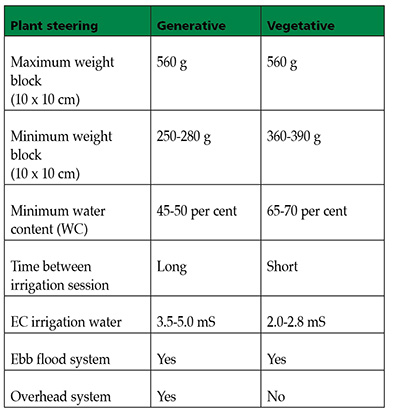 |
Table 4: Reference values for steering plant development with water content and EC during propagation.
To ensure uniform growth of both shoots, the density should be reduced to 70 heads per square metre (35 blocks per square metre) approximately three days after pinching, and seven days later they should be spaced for a second time to 32 heads per square metre (16 blocks per square metre). Finally after a further seven days, they
should be spaced to the final density of 16 heads per square metre (eight blocks per square metre).
SUMMARY
Although grafting is now the standard way to cultivate tomatoes, different plant specifications can be created by the propagator. The plant specification that is the best for you depends on your growing circumstances.
Increasingly, young plants are being steered generatively. The benefits are more compact plants with better cluster formation and root quality.
In warm conditions, temperature is no longer a tool for steering. In these situations, irrigation management can have a massive influence on young plant development especially when steering to low block water contents; however, the uniformity between blocks must be maintained to ensure a uniform batch of plants.
In the next article I will go into more detail on how the plants should be handled prior to and during delivery to the grower to ensure minimal disruption of growth and therefore come one step closer to achieving a high total production.
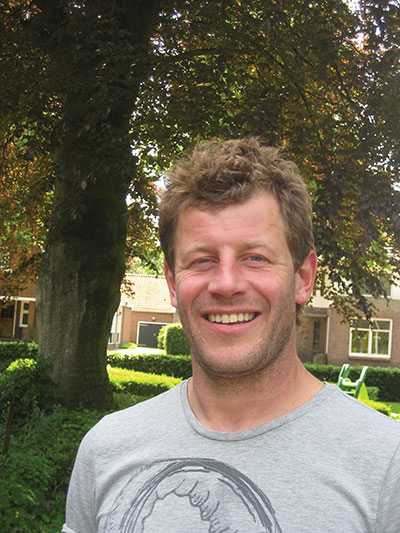 |
|
Hans van Herk is a young plant specialist for Grodan, a leading substrate supplier to the professional horticultural industry.
Print this page